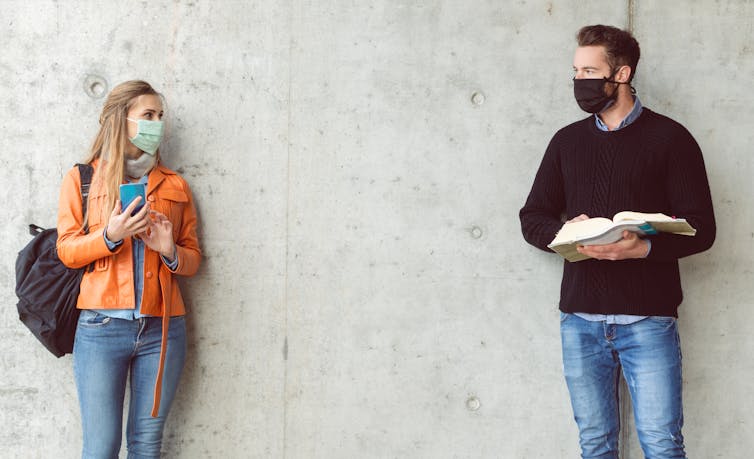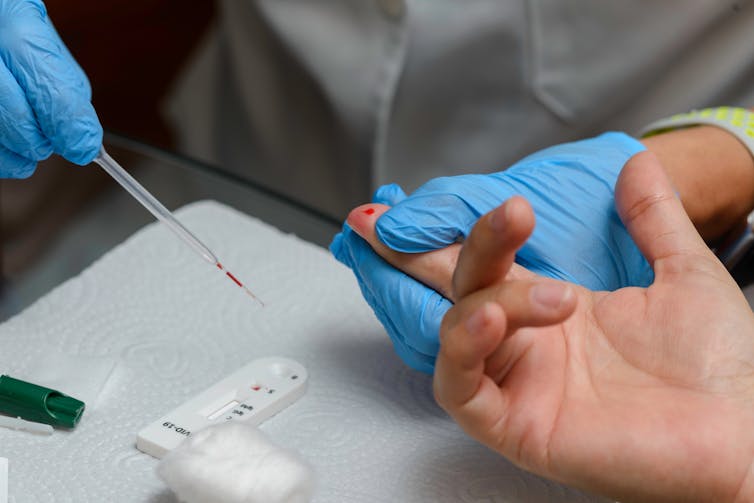
Jessica Williams, Cardiff Metropolitan University
As COVID-19 has swept across the globe, it seems that high transmission rates have partly been driven by a large number of people catching the virus, not experiencing symptoms and then unknowingly passing it on. Despite this, the screening of asymptomatic people for signs of infection hasn’t been widespread, due to costs and limits on testing capacity. We therefore have only limited understanding of the role that asymptomatic people play in the spread of the disease.
There are other things we don’t fully understand either. We know that the production of protective antibodies following an infection forms the basis of immunity. But while it’s clear that infection with the coronavirus results in antibody production, we aren’t sure of the amounts of antibodies produced, how long they last, or whether they protect people from getting COVID-19 again.
Because of the lack of knowledge on these points, we decided to test asymptomatic staff at Cardiff Metropolitan University in July 2020 for the presence of COVID-19 antibodies. As well as helping uncover how common asymptomatic infections were during the first wave, we hoped this would tell us more about how long COVID-19 antibodies may last, and if there are differences in how people’s immune systems respond to the virus. Here’s what we found.
Uncovering differences
To run our screening programme, we used a lateral flow “pregnancy-like” test strip that provided a result from a single drop of blood within ten minutes. These results were then compared to two independent “gold standard” methods used by public health laboratories to test for COVID-19 antibodies. Our study looked at the same people at two time points, three months apart.
At the time of their first test in July 2020, all participants were well, hadn’t previously received a COVID-19 diagnosis and didn’t have any obvious symptoms of disease, though some reported having experienced mild COVID-related symptoms in the three months beforehand.
Of the 739 people we screened, 3.65% had COVID-19 antibodies, which was slightly lower than the national average suggested by the UK REACT study (4-6%) for this point in time. This is perhaps surprising, given Cardiff is an urban area and so might be expected to have higher rates of infection. The lower rate in our study could be explained by the fact that most of our university staff had been working from home between March and September 2020 and so had been largely protected from infection.

Our study didn’t find a statistically significant difference in the number of men and women who had antibodies, although antibody prevalence was highest in men over the age of 40. However, when we compared antibody levels in those who tested positive, we did find a key difference: male participants’ levels were three times those of female participants. This was despite there being no difference in the previous COVID-related symptoms reported by men and women – suggesting no difference in the severity of the infections that produced them.
When we followed up with a second test three months later, we found another key difference. Of those who had previously had antibodies against COVID-19, 21.7% no longer tested positive, implying that one in five asymptomatic people who generate antibodies against COVID-19 lose these after six months (as the likely time of infection for those testing positive in July was roughly three months’ prior to this, at the height of the first wave).
Interestingly, 80% of those who had lost their antibodies in our study were women. The women who had lost their antibodies were also on average ten years older than women who retained antibodies. This may be related to an altered immune response in women who are approaching the menopause or are post-menopausal, similar to that seen in the flu.
Altogether, our results suggest that as we assess immunity to COVID-19 – and its longevity – we need to be prepared for it not to be uniform. Age and sex could result in important differences.
A win for lateral flow testing
It’s been suggested that lateral flow tests like the ones we used could be deployed more widely to detect whether people have COVID-19 antibodies. Compared to conventional testing methods, lateral flow tests are fast and cheap. They require minimal training to use and avoid the need for complex laboratory analysis.

However, using these sorts of tests to screen asymptomatic people has been questioned, as there have been concerns over their accuracy. This has been further hampered by the lack of standardisation across the multitude of companies who have produced these tests for commercial gain.
So, we ran a blinded independent comparison between the lateral flow method we adopted and two government-approved methods for testing for antibodies. Our test correctly identified people with antibodies 96% of the time and people without them 95% of the time.
This level of accuracy suggests that lateral flow tests could be used to effectively monitor people’s antibody production. With COVID-19 vaccines being rolled out across the UK, a practical application of these tests could be to assess how the effectiveness of COVID-19 vaccines may be changing over time at large scale.
Jessica Williams, Research Associate in Cardiovascular Metabolism and Inflammation, Cardiff Metropolitan University
This article is republished from The Conversation under a Creative Commons license. Read the original article.

